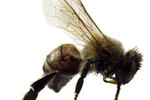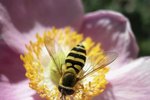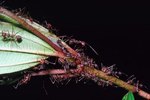
Wasps don't communicate verbally. Their sense of smell helps them communicate with one another. The pheromones that wasps release can communicate danger, attract a mate amd signal where food can be found. They even mark where the wasps have laid their eggs.
Communicating Chemically
Wasps emit chemicals called pheromones, which are highly potent and coded with different meanings. A human can't detect the a wasp's scent, and other insects typically ignore it or even flee from it. Among wasps, though, these pheromones are how they speak to one another. They are instrumental in identifying other wasps from the same nest, among other things.
Attracting Mates
Pheromones are instrumental to the wasp courtship ritual, which is initiated by the male. He releases pheromones into the air that communicate his virility, his identity and his location. A female wasp who is receptive to his pheromones will seek him out -- and not just any male will do. Wasps of different species are attracted to different blends of pheromone chemicals.
Sounding the Alarm
Because wasps invest so much time and energy in building and maintaining their communal nests, they have to be able to quickly warn one another of impending danger so they can all swoop in to defend it. Wasp nests are highly targeted by predators like bears and raccoons, and when such animals, including humans, gets too close for their comfort, wasps may move in and sting. Wasps can sting multiple times. Whenever they do so -- and only females can sting -- they release pheromones that effectively raise the alarm and call nearby wasps to action. This quick chemical communication allows the family to quickly swarm in defense.
Leaving a Trail
Wasps leave trails for one another to follow. Wasps can emit pheromones to mark objects with their scent. In some cases, this may communicate to other wasps where food is available -- they can mark the territory as a signal for others from the same colony to come and feed. Parasitic wasps, which lay their eggs in the bodies of other insects, mark hosts with a scent pheromone signaling to others that they has been claimed.
References
Photo Credits
-
Medioimages/Photodisc/Photodisc/Getty Images
Writer Bio
Tom Ryan is a freelance writer, editor and English tutor. He graduated from the University of Pittsburgh with a degree in English writing, and has also worked as an arts and entertainment reporter with "The Pitt News" and a public relations and advertising copywriter with the Carnegie Library of Pittsburgh.




